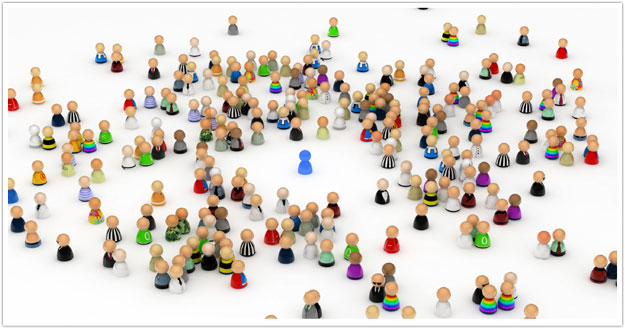The Gathering: Social Marketing, Old School
January 2011
By Jason Ferster

The brave new world of Web 2.0 offers a wide array of platforms that allow businesses to connect virtually with the people who want what they’ve got.
But long before the advent of the Social Web – before anyone had ever heard of Twitter, Meetup, Craigslist or Facebook – social marketing flourished. From Tupperware parties to trade shows, whether in living rooms or convention halls across America, people came together in gatherings to connect with products, sellers and other customers like themselves all at once.
And while today’s culture of hyper-connectivity has dealt much of traditional marketing a fatal blow, the gathering has stood the test of time. In fact, social technology has given new life to the gathering. No longer confined to fixed time slots or venues, the content and conversations of events now live on in perpetuity through social media, event-specific websites and online video.
It’s important to make sure that gatherings have a place in your marketing arsenal.This relationship works in the other direction as well. As communities form around common interests on the Web, real-world gatherings are a natural extension of members’ online interactions. Like a handwritten note in the age of e-mail, the face-to-face connection has become a rarefied, premium experience in a time when virtual connectivity is always only a finger-swipe away.
For these reasons, it’s important to make sure that gatherings have a place in your marketing arsenal and that you’re investing time in engaging with your tribe of followers offline as well as online.
"Ideas worth spreading"
A recent gathering I attended began like a bad joke: an artist, an engineer and a socialite walk into an auditorium. This time, however, there was no punch line.
Instead, I was participating in a
TED event, and the room was electric with the pre-show buzz of right and left brains, liberals and conservatives, vegans and slow-food carnivores wearing “I ♥ Meat” t-shirts.
For decades the famed TEDTalks have brought together artists, angel investors, designers, doctorates, engineers, entrepreneurs, communicators and community leaders, all in pursuit of one common passion: “ideas worth spreading.” With its famously short talks (25 minutes or less), TED is a petri dish for innovation, and most followers would sever their right arm to attend the invitation-only conference in Long Beach, California.
Historically, the group met in druid-like seclusion. But with the ascension of new leadership came a new vision: world-changing ideas should actually be shared with the world. The arrival of online video gave TED a second, virtual life, and in the early 2000s, TED.com began offering free access to full-length videos of its proceedings.
For years, TEDophiles like myself have gobbled up this content online while dreaming of experiencing it in person. Fortunately for us, the masterminds behind TED realized that ordinary people everywhere have ideas that could change the world, or at least their local communities.
So in 2009,
TEDx Events were born, with TED lending its name, brand collateral and mission to independently planned and executed local gatherings. In December 2010 alone, 165 TEDx Events were held in 54 countries.
I myself became an official TEDster on September 24 at the inaugural TEDxCharlotte, right in my hometown. A dream came true as I sat with hippies and hipsters for one glorious day of ideas worth spreading.
As TEDizens like me have discovered, it is the gathering itself that is the holy grail, not just the content and information. The conversations and connections that can be sparked when people meet and share experiences in the real world are deeper and longer-lasting than those that are confined to tweets, Facebook wall posts or even forum message boards.
Gathering your tribe
TED is a shining example of the value of creating opportunities for people to meet and interact with others who share their interests.
Identify the commonalities that unite your tribe.However, you don’t need their massive, worldwide following to harness the power of the gathering to grow your business. You just need to identify the commonalities that unite your tribe and orchestrate an event that taps into their shared passions and provides an outlet for engagement.
Remember that those who would make the effort to spend time and energy with you are your champions. They are people who believe in – or at least are interested in – your product, service or company enough to bother.
You don’t have to dazzle them. But you do have to show up, make authentic connections and give them something of value for their effort.
The end result? They will love and trust you more.
In order to ensure the success of your gathering, here are some key points to keep in mind:
Bigger isn’t necessarily better
Often, the slicker and more carefully controlled the interaction, the less special the event can feel.
Instead, just keep it simple. Invite a handful of your best customers or, if the invitation is open to all, limit registration. This will foster an atmosphere of intimacy and privilege for those in attendance.
Most importantly, don’t use the event as a ruse to assemble your followers for a sales pitch. Be genuine and focus on delivering something of real value.
Show what you know
If you’re a service provider, your customers routinely pay for your knowledge and experience.
Play to your strengths by hosting an educational gathering related to your area of expertise. For example, a lawyer could offer a free estate planning workshop to recent retirees or present a seminar for small business owners about the implications of recent health care legislation.
The payoff for this type of effort is a group of prospective clients who believe in your credibility as a knowledgeable resource and trust in you more than your competitors.
Break out of your box
Perhaps people associate your business with a particular line of services or products even though your catalog is actually much more diverse.
A gathering is a great opportunity to shed some light on your less well-known areas of expertise. For instance, a pest control specialist might know as much about protecting garden vegetables from aphids as floor joists from termites. A lecture to the local garden club could open a new niche market hidden from competitors’ view. Likewise, an interior decorator could offer working moms a workshop about organizing with style, thereby becoming the savior of the super-busy.
The power of privilege
Treat your best customers (the ones you or your staff know by name) to a special appreciation event. Give away products and thank them sincerely for being so faithful to you.
They will love your company all the more and become even more vocal evangelists for your brand.
Party like it’s $19.99
If your brand or your products already have a fan base, give those fans an excuse to get together and have a good time – all under the banner of your brand.
You’re throwing the party. They’re your fans. The conversation will inevitably lead back to you. You don’t have to force it. Think gallery crawls, wine tastings or product launch parties.
For the love of rewards
Oh to be in the audience the day
Oprah gives everyone a new car. Most days, though, you’re at least going home with a free book.

When you host an event, reward the effort people make to attend by giving away products to those who show up. Better yet, give more products to people who bring others with them. In doing so, you’re not only giving them a no-risk way to experience your product or service, but you’re incentivizing them to spread the word to others as well.
Use the Web to promote your gathering
If you want a large event, invite all your Twitter followers. If a smaller gathering of your best customers is what you’re after, send direct messages to only the most active or influential among them.
You can even turn your event into a contest by challenging your Facebook fans to share why they love your products in order to win a place on the guest list. You’ll not only have an instant list of eager attendees, you’ll also reap some great testimonials for later use.
Transcend time and space
When your event is over, share pictures or video online to demonstrate the good time had by all and the value those who attended received. For example, if your event was instructional in nature, offer a recap of the tips that were covered or access to video of a presentation delivered at the event.
Get people talking about your event and keep them talking. The important thing is to get people talking about your event and keep them talking – and sharing, and linking to, and blogging, and status updating and tweeting – about what wonderful people you and your staff are and how much value they find in your product, service or expertise.
By day, Jason Ferster is the marketing manager of an IT consulting firm, where he contends daily with the marketing challenges common to small and mid-sized businesses. By nights and weekends, he writes about insights gained from those experiences. Visit FersterFiles.com for more or connect with Jason on Twitter.